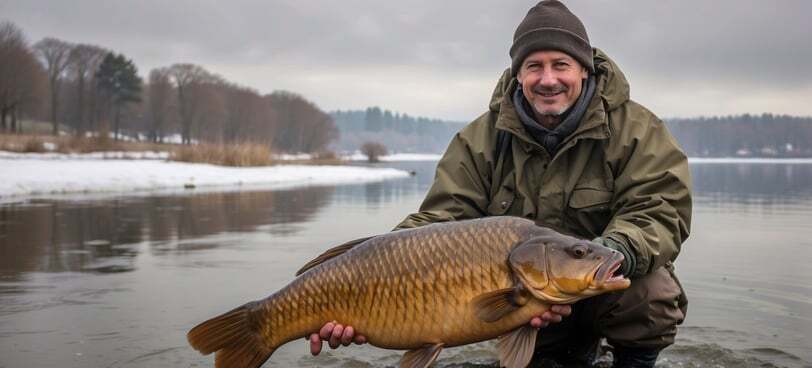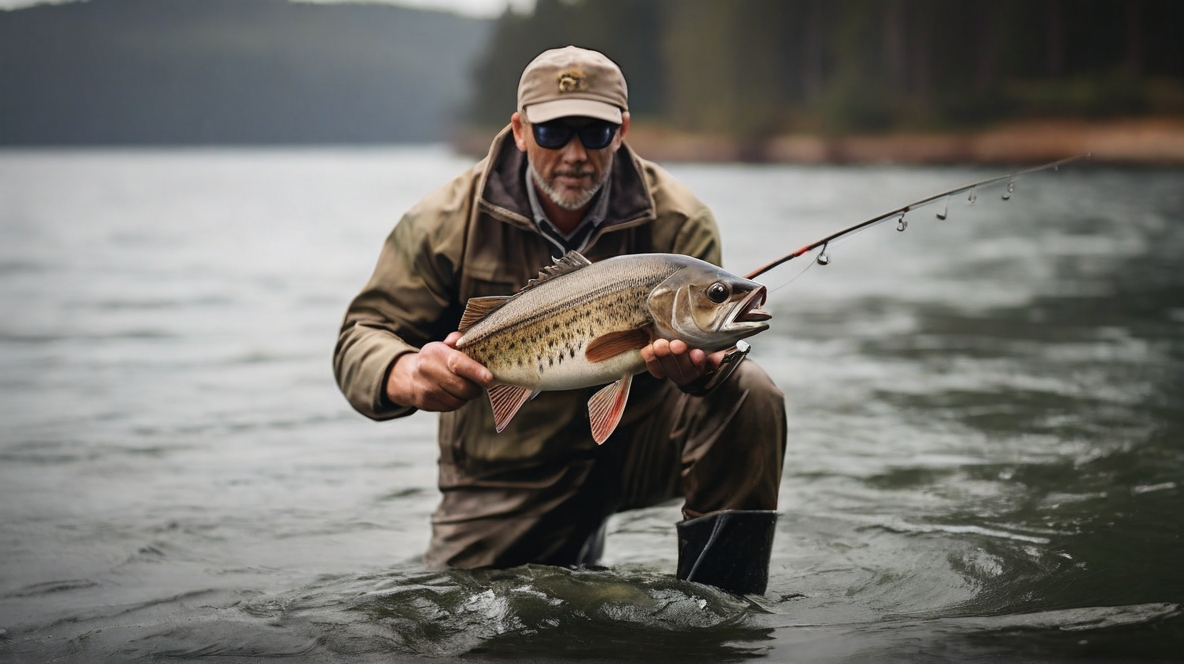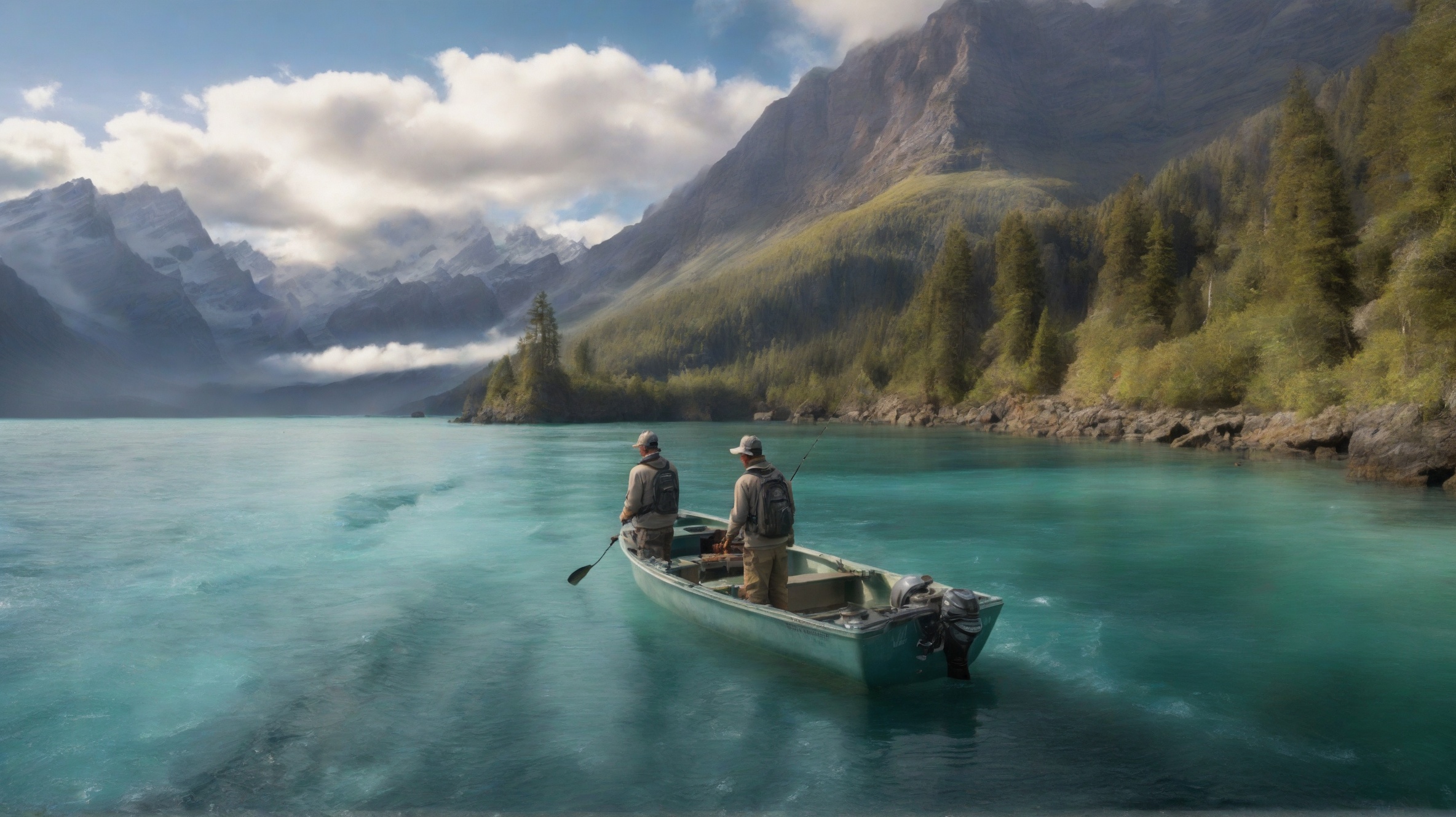
Fall Carp Fishing: Preparing for Winter
As the vibrant colors of autumn foliage grace the landscape and temperatures begin to cool, carp anglers have the opportunity to enjoy some of the year’s most productive and rewarding fishing. Fall marks a transitional period when carp are actively foraging to build up their energy reserves for the impending winter. In this section, we will explore the ins and outs of fall carp fishing, sharing valuable tips and tactics to ensure you make the most of this season’s angling opportunities.
1. Follow the Bait
One of the key principles of successful fall carp fishing is understanding the carp’s feeding patterns and preferences during this transitional season. As temperatures drop, carp become increasingly focused on accumulating energy, which means they are often found near abundant food sources. To make the most of this behavior, consider the following strategies:
Natural Food Sources: Carp in the fall are highly attuned to the availability of natural food sources in their environment. This includes fallen fruits like acorns and berries, as well as insects, crustaceans, and aquatic vegetation. Observing the types of natural food present in your chosen fishing location can help you select the most effective bait.
Mimic Natural Food: To entice fall carp, choose baits that closely mimic the natural food sources they are targeting. Boilies infused with fruity flavors, sweetcorn, and imitation berries can be highly effective. When carp encounter a bait that resembles the natural forage they are actively seeking, they are more likely to investigate and consume it.
Patience Pays Off: During the fall, carp may feed sporadically and take their time to fully commit to a bait. Exercise patience and be prepared for extended waits between bites. Carp are known for their cautious feeding behavior in the fall, so give them time to become confident in your offering.
Adjust Bait Size: Carp may become more selective about the size of the food they consume in the fall. Experiment with different bait sizes to determine what is most appealing to the carp in your chosen fishing spot. Smaller baits can sometimes yield better results during this season.
Stalk the Margins: Carp often forage along the margins of lakes, rivers, and ponds, particularly in the fall. These areas are rich in fallen fruits, insects, and vegetation that carp find irresistible. Stalking the margins and fishing close to the shore can put you in the path of actively feeding carp.
Use Marker Floats: Marker floats or feature-finding techniques can help you identify areas with high natural food concentrations. By pinpointing these hotspots, you can strategically position your bait for increased success.
Observation is Key: Keep a watchful eye on the water’s surface for any signs of carp activity. Carp can be seen splashing, rolling, or bubbling as they feed, giving away their presence. Identifying these telltale signs can guide your bait placement.
In summary, fall carp fishing revolves around following the bait and understanding the natural food sources that carp are actively seeking. By mimicking these food sources with your bait selection and patiently waiting for carp to commit, you can capitalize on the carp’s autumn feeding frenzy. Fall is a season of preparation for carp, and with the right tactics, you can prepare for a successful day on the water.
2. Stalk the Margins
During the fall season, as carp focus on building energy reserves, they often gravitate towards the margins of lakes, rivers, and ponds. These areas provide a bounty of fallen fruits, nuts, and insects, making them prime feeding zones for carp. Here’s how to make the most of this behavior:
Stealthy Approach: Carp are known for their wariness, so approach the margins quietly and with care. Avoid loud noises, sudden movements, or disturbances that could spook the fish. Stay low and out of the carp’s direct line of sight.
Observe the Water: Spend time observing the water’s surface and look for any signs of carp activity. Carp feeding along the margins may create ripples, swirls, or bubbles. These visual cues can guide you to the best spots for setting up your fishing gear.
Position Your Bait: To effectively target carp in the margins, position your bait close to the shore. Use a bank or margin rod setup with shorter casting distances. Baits like sweetcorn, flavored boilies, or imitation berries work well in these areas.
Be Patient: Carp in the margins can be cautious and may take their time inspecting your bait before committing. Exercise patience, resist the urge to recast too frequently, and allow the carp to feel at ease with your offering.
Use Polarized Sunglasses: Polarized sunglasses can help you see below the water’s surface, allowing you to spot carp and their movements more easily. This can be particularly helpful when stalking the margins.
Stay Camouflaged: Wear clothing that blends in with your surroundings and minimizes your visibility to the fish. Carp have keen eyesight, so staying concealed can increase your chances of success.
Chumming: Consider prebaiting or chumming the margins with small amounts of your chosen bait. This can condition the carp to the presence of your bait and create a feeding frenzy when you cast your line.
3. Adjust Your Gear
Fall carp fishing often calls for specific adjustments to your gear and tackle to optimize your chances of success in cooler water temperatures and changing carp behavior.
Warmer Clothing: As the fall season progresses, temperatures can drop significantly. Ensure you have appropriate clothing, including waterproof and wind-resistant gear, to stay comfortable during extended fishing sessions.
Sensitivity Matters: Coldwater carp can exhibit subtle feeding behavior. Use fishing rods with sensitive tips to detect even the slightest indications of carp interest. This will help you respond promptly when a carp takes your bait.
Line and Leader Selection: Choose your fishing line carefully. Thinner monofilament or fluorocarbon lines can be less visible in clear fall water and provide a more natural presentation. Consider using a shock leader to handle the potential power of large carp.
Tackle Ratios: Adjust your tackle ratios to match the potential size of carp in your chosen fishing spot. Fall is a time when carp are actively feeding and bulking up for winter, so be prepared for larger, more powerful fish.
Bait Presentation: Tailor your bait presentation to match the seasonal changes. Carp may be less active in cooler water, so adjust the size and flavor of your baits accordingly. Smaller, highly flavored baits can be particularly effective.
Rig Setup: Use rigs that suit the conditions. A hair rig with a balanced bait can be highly effective for fall carp fishing. Ensure your rigs are well-tied, and hooks are sharp to improve hooking success.
In conclusion, fall carp fishing is a season of preparation for both anglers and carp alike. By targeting the margins, adjusting your gear, and understanding the carp’s changing behavior, you can make the most of this transitional period. Fall offers excellent opportunities to land prized carp as they build up energy for the winter, making it a favored season for dedicated carp anglers. With the right strategies and adaptations, you can enjoy fruitful and memorable fall carp fishing experiences.

Carp Fishing in Winter: A Cold but Rewarding Pursuit
Winter carp fishing may seem like a daunting endeavor, with plummeting temperatures and carp becoming less active in colder water. However, for dedicated anglers willing to brave the elements, winter can be an incredibly rewarding season to pursue carp. Carp may feed less frequently and more cautiously during this time, but with the right strategies and patience, you can still experience successful winter carp fishing. In this section, we’ll explore the intricacies of this cold-season pursuit, providing insights and tips to help you make the most of your winter carp fishing adventures.
1. Fish Slow and Deep
Winter is a season of reduced metabolic activity for carp, leading them to become less active and less likely to chase fast-moving baits. To adapt to this change in carp behavior, you’ll need to adjust your tactics accordingly:
Target Deeper Waters: As temperatures drop, carp tend to seek out deeper parts of lakes, ponds, or rivers where the water is warmer and more stable. Use a fish finder or depth sounder to locate these preferred areas and concentrate your efforts there.
Slower Bait Presentation: Slow down your bait presentation. Carp in cold water are less inclined to expend energy chasing after fast-moving baits. Employ a method known as “static fishing,” which involves keeping your bait stationary on the lake or riverbed.
Bottom Baits: Carp often forage near the bottom in winter, so bottom baits are a reliable choice. Use heavy leads or sinkers to ensure your bait reaches the lake or riverbed and stays there. Baiting with items like boilies, pellets, or corn that sink naturally can be effective.
Use Smaller Baits: Carp may have smaller appetites in winter, so consider downsizing your baits. Smaller offerings like single boilies or small bundles of sweetcorn can be appealing to carp in cold water.
Natural Flavors: In winter, carp may be more selective about bait flavors. Natural, subdued flavors like earthworm, bloodworm, or fishmeal can be attractive to carp. These flavors closely resemble the natural food sources available to carp in colder water.
Rig Setups: Opt for rig setups that minimize resistance when carp pick up your bait. A hair rig with a small, sharp hook can increase your chances of a successful hookset while allowing the carp to take the bait more easily.
Be Patient and Persistent: Winter carp fishing requires a great deal of patience. Carp may take longer to investigate your bait and decide to take it. Be prepared for extended waiting periods and refrain from disturbing your fishing spot unnecessarily.
Stay Warm and Comfortable: Dress warmly in layered clothing to combat the cold temperatures. Use insulated boots, gloves, and thermal undergarments to keep warm. A comfortable angler is more likely to maintain focus and patience during long winter fishing sessions.
In conclusion, winter carp fishing presents unique challenges, but it can be an incredibly rewarding pursuit for those willing to adapt their strategies. Fishing slow and deep, using smaller baits with natural flavors, and maintaining patience are key to success during this cold season. With the right preparations and dedication, you can enjoy the serenity of winter waters and the satisfaction of landing carp even in the chilliest of conditions.
2. Use Highly Attractive Hookbaits
In the frigid waters of winter, it’s essential to capture the attention of lethargic carp with exceptionally attractive hookbaits. These hookbaits serve as the focal point of your presentation and can make all the difference in getting a carp to commit. Here are some tips on selecting and using highly attractive hookbaits during winter carp fishing:
Bright Colors: Brightly colored hookbaits can stand out against the muted underwater backdrop of winter. Fluorescent and high-visibility hookbaits in colors like pink, orange, or yellow can be particularly effective. These eye-catching hues can pique the curiosity of passing carp.
Flavored and Scented Baits: In cold water, carp rely heavily on their sense of smell to locate food. Infuse your hookbaits with potent flavors or scents that can be detected from a distance. Flavored and scented pop-up boilies or corn can be excellent choices.
Air Injected Baits: Air-injected hookbaits are designed to float just above the lake or riverbed. They mimic the behavior of natural food sources that carp find during winter, such as rising insects or buoyant invertebrates. This subtle movement can trigger the curiosity of carp.
Slow-Sinking Hookbaits: Slow-sinking hookbaits, also known as wafters, can be highly effective in winter. These baits slowly descend to the lake or riverbed, providing carp with ample time to inspect and commit. Combine slow-sinking hookbaits with snowman rigs for added appeal.
Dip or Soak Baits: Soaking your hookbaits in a potent liquid or glug can intensify their attractiveness. These liquids can create a trail of scent in the water, guiding carp to your bait. Experiment with different dips and soaks to find the most appealing combination.
Matching the Hatch: Observe the natural food sources available to carp in winter waters and attempt to mimic them with your hookbaits. If you notice small aquatic creatures or larvae in the water, select hookbaits that closely resemble them in size, color, and texture.
Change Hookbaits Periodically: Carp can become wary of the same hookbait if it’s left in place for an extended period. Change your hookbaits regularly to maintain their appeal. It’s a good practice to swap out hookbaits every few hours, even if you haven’t had any bites.
Fine-Tune Your Presentation: Pay attention to how carp are responding to your hookbaits. If you notice that they are repeatedly investigating but not committing, consider adjusting the color, size, or flavor of your hookbait until you find what entices them.
By using highly attractive hookbaits, you can increase the chances of capturing the interest of winter carp. These baits serve as the alluring centerpiece of your presentation, enticing carp to investigate and ultimately take the bait. Experiment with different options and stay attuned to the preferences of carp in your chosen fishing spot to maximize your success.
3. Night Fishing in Winter
Winter nights may be long and bitterly cold, but they offer a prime opportunity for dedicated anglers to pursue carp. Carp are more likely to feed during the nighttime hours in winter, making night fishing an effective strategy. Here’s how to prepare for and make the most of winter night fishing:
Plan for Extended Darkness: Winter nights can be considerably longer than summer nights. Prepare for the extended darkness by bringing adequate lighting, warm clothing, and essential supplies to ensure your comfort and safety throughout the night.
Use Bite Alarms: Bite alarms are invaluable during night fishing sessions. These devices emit a sound or light signal when a carp takes your bait, allowing you to respond promptly and make a successful hookset, even in the darkness.
Choose Highly Attractive Baits: Since carp are more likely to be actively feeding at night, select highly attractive baits that can draw them in from a distance. Brightly colored and flavored baits, as well as slow-sinking options, can be particularly effective.
Stay Quiet and Discreet: Carp have excellent hearing, even in the darkness. Move and work around your fishing spot quietly to avoid spooking the fish. Keep unnecessary noise to a minimum to maintain a stealthy presence.
Thermal Gear: Dress in thermal clothing and layer up to combat the cold temperatures of winter nights. Insulated boots, waterproof outerwear, and thermal gloves are essential to stay warm and comfortable during extended night fishing sessions.
Safety First: Always prioritize safety when night fishing. Inform someone of your fishing location and expected return time. Carry essential safety gear, such as a flashlight, first-aid kit, and extra warm clothing. Additionally, maintain situational awareness to avoid potential hazards in the dark.
In summary, night fishing during winter can be a highly productive approach to carp angling. Carp are more likely to feed during the nighttime hours, and by using highly attractive hookbaits, bite alarms, and proper night fishing gear, you can increase your chances of success. Embrace the challenges of winter nights, and you may find that some of your most memorable carp catches occur under the stars.
Carp fishing is a year-round pursuit that offers a unique and rewarding angling experience in each season. Whether you’re casting your line during the vibrant days of spring, the scorching heat of summer, the colorful transition of fall, or the cold depths of winter, understanding the nuances of each season is the key to success.
In spring, seize the opportunity to target active carp in shallower waters. Knowing where to find them, choosing the right bait, and timing your fishing sessions can lead to a successful outing during this season of awakening.
Summer brings its own set of challenges, but night fishing, targeting deeper waters, and using light tackle can help you overcome them. Embrace the night to tap into the carp’s increased activity under the cover of darkness.
During fall, observe the carp’s feeding behavior and follow the natural food sources they seek. Stalking the margins and making thoughtful adjustments to your gear can help you capitalize on their feeding frenzy as they prepare for winter.
Winter, though cold and demanding, can be incredibly rewarding when you slow down your approach, use highly attractive hookbaits, and engage in night fishing. The tranquility of winter waters and the satisfaction of landing carp in challenging conditions make it a season to remember.
In all seasons, patience, observation, and adaptability are essential traits for successful carp anglers. Carp fishing is not just about the catch; it’s a holistic experience that allows you to connect with nature, test your skills, and enjoy the serenity of the water.
As you embark on your year-round carp fishing adventures, remember to prioritize safety and comfort. Dress appropriately for the weather, stay organized with your gear, and maintain a respectful relationship with the environment and fellow anglers.
Ultimately, carp fishing is a journey filled with discovery, learning, and the thrill of the catch. Each season offers its own unique challenges and opportunities, ensuring that every outing is a chance to grow as an angler and create cherished memories on the water. So, gear up, embrace the seasons, and let the pursuit of carp fishing take you on an unforgettable journey through the changing tides of nature.








